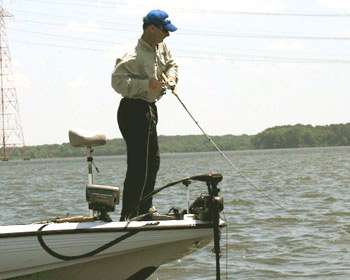
For the tournament bass angler, a successful day on the water is measured by the total weight of the best five bass and not the number of bass caught. Culling through scores of smaller bass means more time spent unhooking and re-rigging, and less time with the bait in the water.
Even the causal weekend bass angler can appreciate a pair of 4-pound largemouth compared to a dozen "dinks." For Elite Series angler Mark Menendez, his livelihood depends on finding quality bass day in and day out.
Over the past two decades, the Kentucky pro has developed some strategies to key in on the bigger bass out of a school. When approaching an offshore fishing location, Menendez makes sure that he is locked and loaded from the first cast. "When you find a school of fish, you are generally in a deeper water situation like a ledge fishing situation.
What I have found is that there is a distinctive pecking order when you find that school of fish and get them active — the bigger fish eat first," explains Menendez. He has found that while the bigger fish eat first, they also take over and occupy the prime ambush points on offshore structure. With this in mind, Menendez looks for irregularities or unique features in the structure.
"I'm trying to hit that one spot because the bigger fish tend to take the best ambush points away from the smaller fish," says Menendez. While structure irregularity is an important component in Menendez' big fish success, two other elements are also crucial when targeting the larger bass within a school. "There are two elements that tend to position fish.
One is wind, and the other is current," Menendez explains. "Current always takes precedence over wind. If you're on a lake that does not have a natural current flow, then wind is going to position that fish. But on a river system where dams generate electricity and current, current will always take precedence over that." Menendez has found that when the current is running, schools of larger fish often tuck in behind pieces of offshore structure. Menendez keeps his lure selection simple but sizable.
"I'm generally going to get that bigger fish to bite on a big crankbait like a Series 6 Strike King where I'm targeting a specific piece of cover and trying to hit that cover to create a deflection," says Menendez. "The deflection will cause the bass to immediately respond to the bait." If he is unable to garner a response with the crankbait, he follows up with a beefy 1-ounce spinnerbait featuring large blades.
"Bass are like people in that the bigger the bass, the bigger the meal they want with the least amount of energy expended. The one-two punch of a big crankbait followed up with the big spinnerbait is generally how I've caught my bigger bass out of schools," allows Menendez. One final critical element in Menendez' big bass success is duplication and repetition once he has identified a prime area. "The one thing that I always do when I have a successful cast and catch a bass is immediately make an identical presentation," Menendez explains.
"That puts a lot more fish into my livewell over time." In order to make the identical presentation, Menendez keeps a buoy on the front deck and kicks it into the water immediately after hooking up. The work doesn't stop once the bass is in the boat. "As soon as I get that first fish in the boat, I don't take a Kodak moment, I don't high-five with my fishing partner. I put the fish in the livewell and make the identically same cast.
That's how I fire that school up and keep on that initial spot." Menendez recalls a team tournament that he fished several years ago where speed and accuracy paid off with numbers of big bass. "I'll always have four or five of the same lures tied on rods, and in that tournament I actually had seven crankbaits tied on seven different rods. I was catching them and putting them in the bottom of the boat while my team partner was down there culling.
I went through my seven rods and my partner's five rods as he was culling them out. I ended up catching five that weighed over 32 pounds in a matter of about 12 casts."
(Provided by Z3 Media)




